Comparative Analysis of Prediction Models for Trawling Grounds of the Argentine Shortfin Squid Illex argentinus in the Southwest Atlantic High Seas Based on Vessel Position and Fishing Log Data
Simple Summary
Abstract
1. Introduction
2. Materials and Methods
2.1. Data Sources
2.1.1. Vessel Position Data and Fishing Log Data
2.1.2. Oceanographic Data
2.2. Data Processing Methods
2.2.1. Fishing Activity Classification
2.2.2. Correlation Analysis
2.2.3. CNN-Attention Model
3. Results
3.1. Fishing State Classification and Fishing Ground Level Determination
3.2. The Relationship Between Time, Space, and Environmental Factors
3.3. Accuracy and Prediction Validation of the CNN-Attention Model
4. Discussion
4.1. Fishing State Classification Based on Vessel Position Data
4.2. Ocean Environment Variability and Its Impact on Fishing Grounds
4.3. Comparison of Fishing Ground Prediction Effectiveness
5. Conclusions
Author Contributions
Funding
Institutional Review Board Statement
Informed Consent Statement
Data Availability Statement
Acknowledgments
Conflicts of Interest
References
- Jéssica, P.B.; Fernanda, C.S.; Juan, P.Q.; Sergio, R.F. Broken expectations: Population decline of a key grouper species within a 30-year-old no-take MPA in the Southwestern Atlantic. Ocean Coast. Manag. 2024, 257, 107318. [Google Scholar] [CrossRef]
- Araujo, L.D.; Freitas, F.S.; Santos, F.R.; Taniguchi, S.; Timoszczuk, C.T.; Burone, L.; Bícego, M.C. Distributions and sources of bulk organic matter from surface sediments along the Southwestern Atlantic Margin. J. S. Am. Earth Sci. 2024, 133, 104729. [Google Scholar] [CrossRef]
- Liu, H.W.; Yu, W.; Chen, X.J. A review of Illex argentinus resources and the responses to environmental variability in the southwest Atlantic Ocean. Chin. J. Fish. Sci. 2020, 27, 1254–1265. [Google Scholar] [CrossRef]
- Boussidi, B.; Le Goff, C.; Galard, C.; Carton, X.; Speich, S. The analysis of north Brazil current rings from automatic identification system data and Altimetric currents. Remote Sens. 2024, 15, 2828. [Google Scholar] [CrossRef]
- Yue, D.D.; Wang, L.m.; Fan, W.; Zhang, X.; Zheng, H.f.; Tang, F.h.; Zhang, S.m.; Dai, Y.y. Illex argentinus Fishery Resources Management in Argentina and its Enlightenment for China. J. Agric. Sci. Technol. 2014, 16, 124–131. [Google Scholar] [CrossRef]
- Xiang, D.L.; Li, Y.; Jiang, K.J.; Han, H.B.; Wang, Y.H.; Yang, S.L.; Zhang, H.; Sun, Y.Y. Environmental influences on Illex argentinus trawling grounds in the southwest Atlantic high seas. Fishes 2024, 6, 209. [Google Scholar] [CrossRef]
- Lin, D.M.; Chen, X.J.; Chen, Y.; Fang, Z. Sex-specific reproductive investment of summer spawners of Illex argentinus in the southwest Atlantic. Invertebr. Biol. 2015, 134, 203–213. [Google Scholar] [CrossRef]
- Sacau, M.; Pierce, G.J.; Wang, J.; Arkhipkin, A.I.; Portela, J.; Brickle, P.; Cardoso, X. The spatio-temporal pattern of Argentine shortfin squid Illex argentinus abundance in the southwest Atlantic. Aquat. Living Resour. 2005, 18, 361–372. [Google Scholar] [CrossRef]
- Arkhipkin, A.; Laptikhovsky, V. Seasonal and interannual variability in growth and maturation of winter-spawning Illex argentinus (Cephalopoda, Ommastrephidae) in the southwest Atlantic. Aquat. Living Resour. 1994, 7, 221–232. [Google Scholar] [CrossRef]
- Zhang, W.; Zhang, J. A discussion about the relationship between the distribution of production of Illex argentinus and marine environmental factors in the Southwest Atlantic Ocean. J. Shanghai Ocean Univ. 2008, 17, 471–475. [Google Scholar]
- Chen, P.; Chen, X.J. Analysis of habitat distribution of Argentine shortfin squid (Illex argentinus) in the southwest Atlantic Ocean using maximum entropy model. J. Fish. China 2016, 40, 893–902. [Google Scholar] [CrossRef]
- Wang, F.; Du, X.; Zhang, W.; Nie, L.; Wang, H.; Zhou, S.; Ma, J. Remote sensing LiDAR and hyperspectral classification with Multi-Scale graph Encoder–Decoder network. Remote Sens. 2024, 16, 3912. [Google Scholar] [CrossRef]
- Li, X.; Chen, P.; Yang, J.; An, W.; Luo, D.; Zheng, G.; Lu, A. Extracting ship and heading from Sentinel-2 images using convolutional neural networks with point and vector learning. J. Oceanol. Limnol. 2024, 1–13. [Google Scholar] [CrossRef]
- Guo, Z.; Cheng, L.; Chang, L.; Li, S.; Li, Y. A modified method for reducing the scale effect in land surface temperature downscaling at 10 m resolution. Remote Sens. 2024, 16, 3908. [Google Scholar] [CrossRef]
- Oka, M.; Komoriyama, Y.; Ma, C. Accuracy verification of the 2D spectral AIS method by the hull monitoring data. Mar. Struct. 2025, 99, 103704. [Google Scholar] [CrossRef]
- Mesquita, C.; Dobby, H.; Jones, C.S.; Pierce, G.J. Estimating fishing effort and LPUE for the Scottish brown crab (Cancer pagurus) trap fishery using VMS and observer data. Fish. Res. 2024, 274, 106974. [Google Scholar] [CrossRef]
- Chuaysi, B.; Kiattisin, S. Fishing vessels behavior identification for combating IUU fishing: Enable traceability at sea. Wireless Personal Commun. 2020, 115, 2971–2993. [Google Scholar] [CrossRef]
- Ren, Y.C.; Liu, J.; Zhai, Z.G.; Wang, W.; Lin, X. Identification of types of fishing applied by vessels in offshore waters in Zhejiang based on support vector machine. J. Jiaxing Univ. 2020, 32, 82–89. [Google Scholar] [CrossRef]
- Sun, H.Y.; Zhou, Y.B.; Ma, S.W.; Tian, J.; Xu, J.; Liu, Z.; Bi, J.; Wu, Q. Fishing characteristics of light fishing vessels in open South China Sea based on Beidou position data. South China Fish. Sci. 2023, 19, 21–30. [Google Scholar] [CrossRef]
- Yang, S.L.; Zhang, S.M.; Yuan, Z.H.; Dai, Y.; Zhang, H.; Zhang, B.B.; Fan, W. Calculating the fishing intensity of offshore longline fleets on fishing grounds based on their fishing characteristics. J. Fish. Sci. China 2020, 27, 307–314. [Google Scholar]
- Han, H.; Yang, C.; Jiang, B.; Shang, C.; Sun, Y.; Zhao, X.; Xiang, D.; Zhang, H.; Shi, Y. Construction of chub mackerel (Scomber japonicus) fishing ground prediction model in the northwestern Pacific Ocean based on deep learning and marine environmental variables. Mar. Pollut. Bull. 2023, 193, 115158. [Google Scholar] [CrossRef] [PubMed]
- Cui, X.S.; Tang, F.H.; Zhou, W.F.; Wu, Z.L.; Yang, S.L.; Hua, C.J. Fishing ground forecasting model of Ommastrephes bartramii based on support vector machine (SVM) in the Northwest Pacific Ocean. South China Fish. Sci. 2016, 12, 1–7. [Google Scholar] [CrossRef]
- Yang, S.L.; Shi, H.M.; Fan, W.; Zhang, H.; Fei, Y.J.; Zhang, H. Spatial distribution of squid fishing vessel operations in the southwest Atlantic Ocean and its relationship with environmental factors. J. Fish. Sci. China 2022, 29, 365–376. [Google Scholar]
- Sun, Y.W. Research on Thermal Analysis of Fishing Vessels Based on AIS Data. Master’s Thesis, Dalian Ocean University, Dalian, China, 2023. [Google Scholar] [CrossRef]
- Bo, J.N.; Li, R.G.; Lyu, D.J.; Chang, Y.F.; Song, W.H. Investigation on fishing methods of double-boat trawling gear along the coast of Uruguay in the southwest Atlantic. Ocean Dev. Manag. 2019, 36, 61–64. [Google Scholar] [CrossRef]
- Witt, J.M.; Godley, J.B. A step towards seascape scale conservation: Using vessel monitoring systems (VMS) to map fishing activity. PLoS ONE 2017, 12, e0181111. [Google Scholar] [CrossRef]
- Deng, R.; Dichmont, C.; Milton, D.; Haywood, M.; Vance, D.; Hall, N.; Die, D. Can vessel monitoring system data also be used to study trawling intensity and population depletion? The example of Australia’s northern prawn fishery. Can. J. Fish. Aquat. Sci. 2005, 62, 611–622. [Google Scholar] [CrossRef]
- Lamchin, M.; Lee, W.-K.; Jeon, S.W.; Wang, S.W.; Lim, C.-H.; Song, C.; Sung, M. Corrigendum to “Mann-Kendall monotonic trend test and correlation analysis using spatio-temporal dataset: The case of Asia using vegetation greenness and climate factors” [MethodsX 5 (2018) 803–807]. MethodsX 2019, 6, 1379–1383. [Google Scholar] [CrossRef]
- Yue, G.C.; Liu, Y.F.; Luo, X. Structure of plankton communities in Muli mining area and their environmental impact factors. J. Anhui Agric. Sci. 2024, 17, 66–71. [Google Scholar]
- Xie, P.F.; Wang, Z.C.; Xu, J.Q.; Bao, R.X.; Tian, X.Q.; Yang, Q.; Yang, X.; Zhang, X.L. Studies on diversity of bacterioplankton community and influencing environmental factors in the East China Sea. Mar. Fish. 2024, 1–13. [Google Scholar] [CrossRef]
- González-Fernández, D.; Román, R.; Mateos, D.; Herrero del Barrio, C.; Cachorro, V.E.; Copes, G.; Sánchez, R.; García, R.D.; Doppler, L.; Herrero-Anta, S.; et al. Retrieval of solar shortwave irradiance from all-sky camera images. Remote Sens. 2024, 16, 3821. [Google Scholar] [CrossRef]
- Lai, K.; Dai, X.J.; Pan, S.B.; Su, B. Fault diagnosis study of power distribution terminal acquisition module based on STFT and CNN-Attention. Automat. Instrum. 2023, 44, 37–41. [Google Scholar] [CrossRef]
- Xiang, D.L.; Sun, Y.Y.; Zhu, H.J.; Wang, J.H.; Huang, S.S.; Han, H.B.; Zhang, S.M.; Shang, C.; Zhang, H. Prediction of the relative resource abundance of the Argentine shortfin squid Illex argentinus in the high sea in the southwest Atlantic based on a deep learning model. Animals 2024, 14, 3106. [Google Scholar] [CrossRef] [PubMed]
- Zhang, S.M.; Tang, F.H.; Jin, S.F.; Wu, Y.M.; Xu, L.H.; Dai, Y. Trawler state and net times extraction based on data from Beidou vessel monitoring system. Fish. Inform. Strateg. 2015, 205–211. [Google Scholar] [CrossRef]
- Zheng, Y.Z.; Lv, X.M.; Qian, L.; Liu, X.Y. An optimal BP neural network track prediction method based on a GA–ACO hybrid algorithm. J. Mar. Sci. Eng. 2022, 10, 1399. [Google Scholar] [CrossRef]
- He, Y.X.; Yu, D.Q.; Liu, X.; Wang, F.; Mou, J. Dynamic adaptive method of autonomous navigation decision-making in the Chengshanjiao waters. J. Harbin Eng. Univ. 2023, 1680–1688. Available online: https://link.cnki.net/urlid/23.1390.U.20230711.1257.002 (accessed on 11 July 2023).
- Yu, D.; He, Y.; Zhao, X.; Chen, J.; Liu, J.; Huang, L. Dynamic adaptive autonomous navigation decision-making method in traffic separation scheme waters: A case study for Chengshanjiao waters. Ocean Eng. 2023, 285, P2. [Google Scholar] [CrossRef]
- Takahashi, N.; Richards, K.J.; Schneider, N.; Stuecker, M.F.; Annamalai, H.; Nonaka, M. Observed relative contributions of anomalous heat fluxes and effective heat capacity to sea surface temperature variability. Geophys. Res. Lett. 2023, 50, e2023GL103165. [Google Scholar] [CrossRef]
- Wekerle, C.; McPherson, R.; von Appen, W.J.; Wang, Q.; Timmermann, R.; Scholz, P.; Kanzow, T. Atlantic water warming increases melt below Northeast Greenland’s last floating ice tongue. Nat. Commun. 2024, 15, 1336. [Google Scholar] [CrossRef]
- Bingham, M.F.; Brodnitz, S. Seasonal phase relationships between sea surface salinity, surface freshwater forcing, and ocean surface processes. J. Mar. Sci. Eng. 2024, 12, 1639. [Google Scholar] [CrossRef]
- Haditiar, Y.; Ikhwan, M.; Mahdi, S.; Siregar, A.N.; Haridhi, H.A.; Setiawan, I.; Irham, M. Oceanographic characteristics in the north of Aceh waters. Reg. Stud. Mar. Sci. 2024, 50, 103408. [Google Scholar] [CrossRef]
- Hao, Y.X.; Wan, R.; Zhou, C.; Ye, X.; Guan, Q.; Zhang, X. Hydrodynamic performance of Argentine shortfin squid (Illex argentinus) bottom trawl. South China Fish. Sci. 2022, 18, 118–127. [Google Scholar] [CrossRef]
- Lu, H.; Zhao, M.; Chen, Z.; Chen, X. The mechanism of gonadal development in response to environmental factors in dwarf-form individuals of female Sthenoteuthis oualaniensis in the South China Sea. Fish. Res. 2024, 272, 106953. [Google Scholar] [CrossRef]
- Gong, C.X.; Chen, X.J.; Gao, F. Modeling the potential distribution of the neon flying squid (Ommastrephes bartramii) in the Northwest Pacific Ocean based on a MaxEnt model. J. Fish. Sci. China 2020, 27, 336–345. [Google Scholar]
- Li, N.; Chen, X.J.; Wang, R. Incorporating spatial autocorrelation into CPUE standardization with an application to Illex argentinus. Acta Oceanol. Sin. 2018, 37, 61–68. [Google Scholar] [CrossRef]
- Chen, J.L. Research on the Construction of a Deep Learning-Based Prediction Model for Iris Squid Fishery in the Northwest Indian Ocean. Master’s Thesis, Dalian Ocean University, Dalian, China, 2024. [Google Scholar] [CrossRef]
- Zhang, F.; Yuan, B.; Huang, L.; Wen, Y.; Yang, X.; Song, R.; van Gelder, P. Fishing behavior detection and analysis of squid fishing vessel based on multiscale trajectory characteristics. J. Mar. Sci. Eng. 2023, 11, 1245. [Google Scholar] [CrossRef]
- Hsu, F.; Elvidge, C.D.; Baugh, K.; Zhizhin, M.; Ghosh, T.; Kroodsma, D.; Sudarja, Y. Cross-matching VIIRS boat detections with vessel monitoring system tracks in Indonesia. Remote Sens. 2019, 11, 995. [Google Scholar] [CrossRef]
- Yağ, İ.; Altan, A. Artificial intelligence-based robust hybrid algorithm design and implementation for real-time detection of plant diseases in agricultural environments. Biology 2022, 11, 1732. [Google Scholar] [CrossRef]



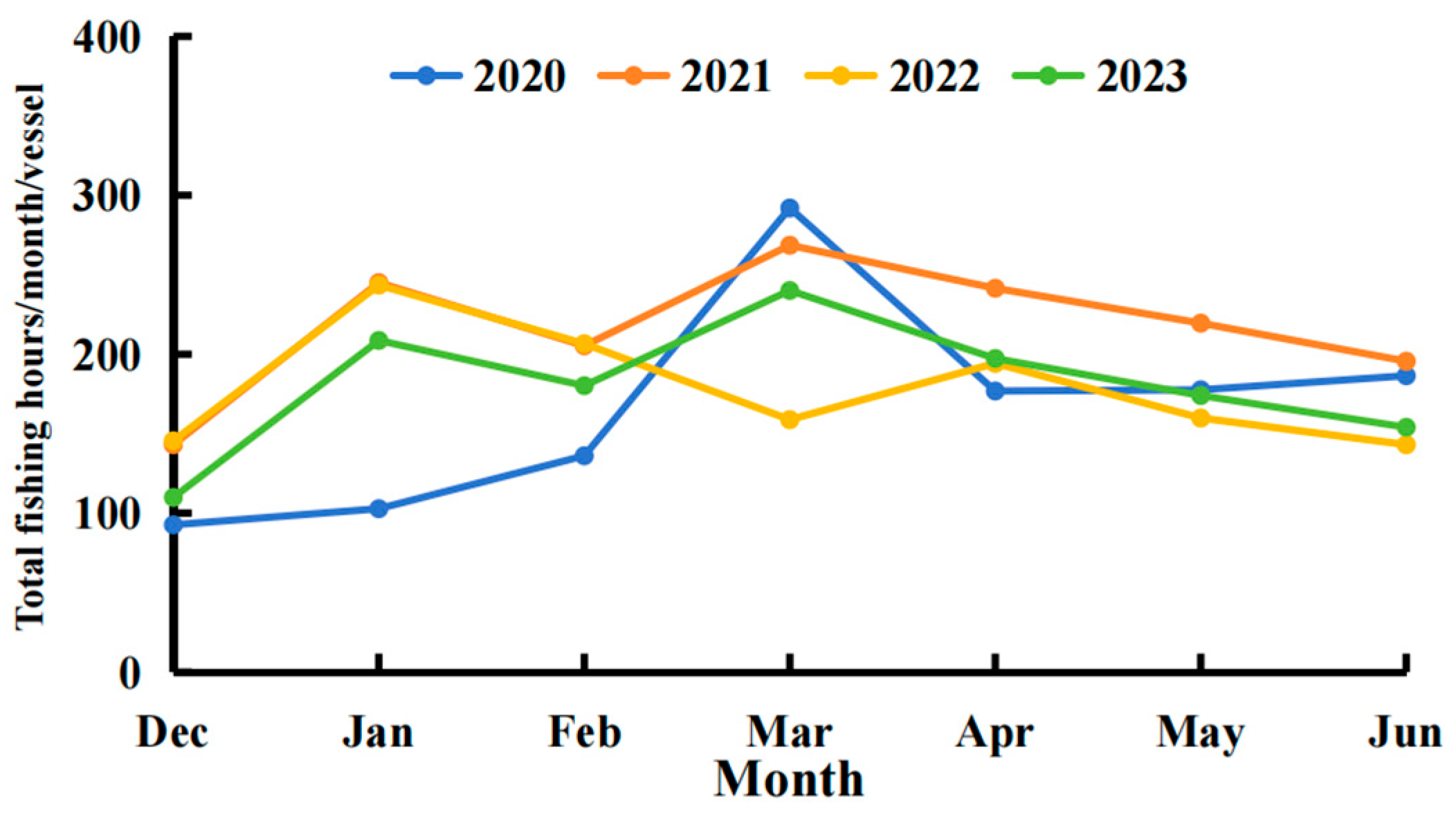
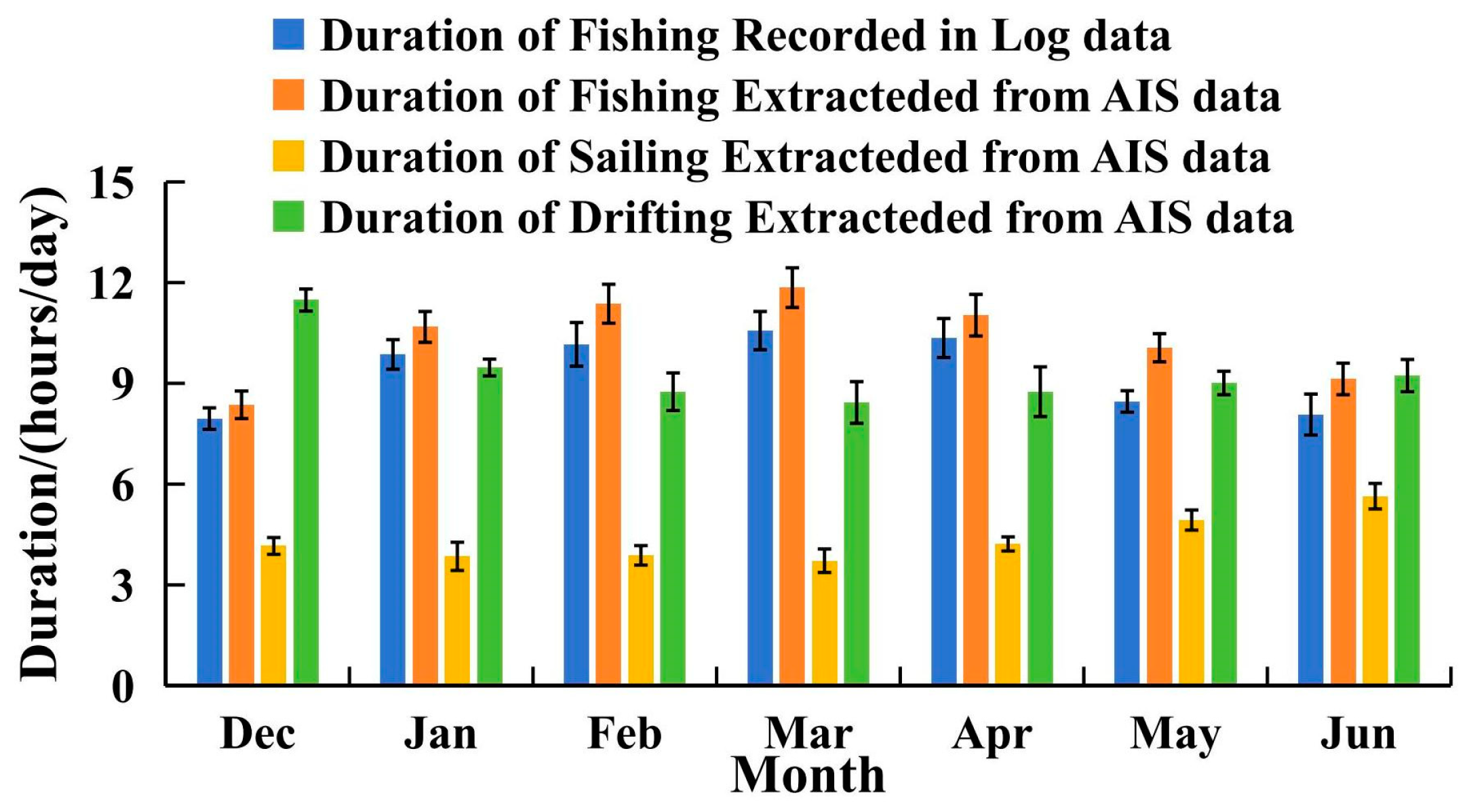

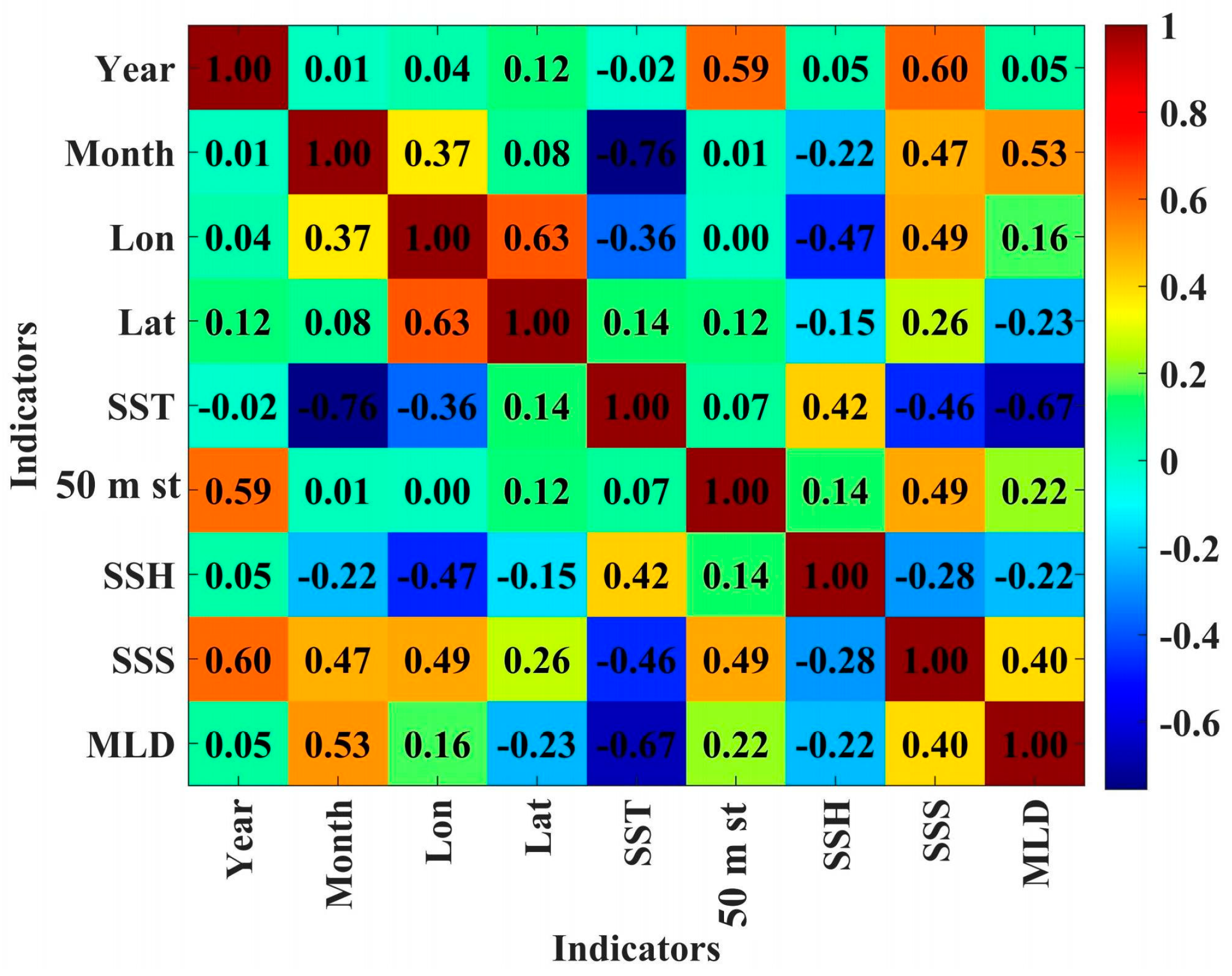

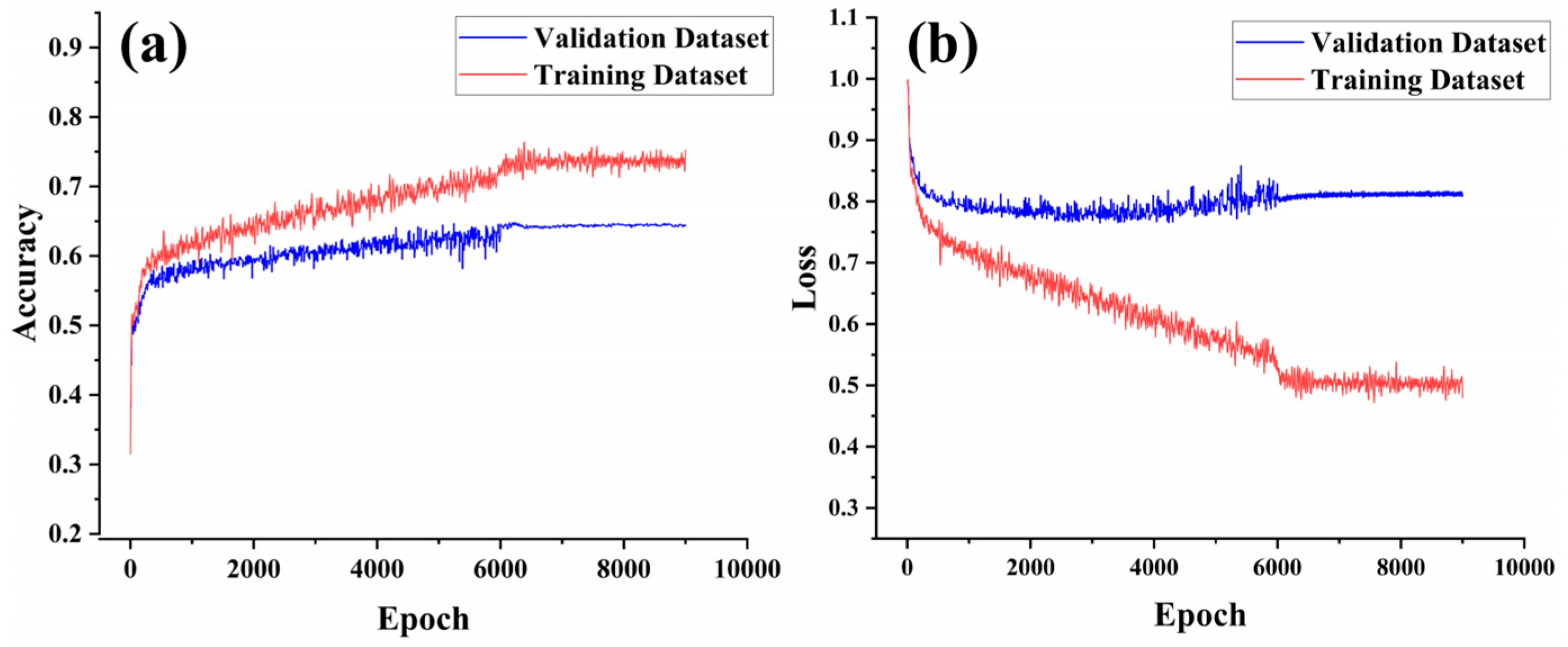
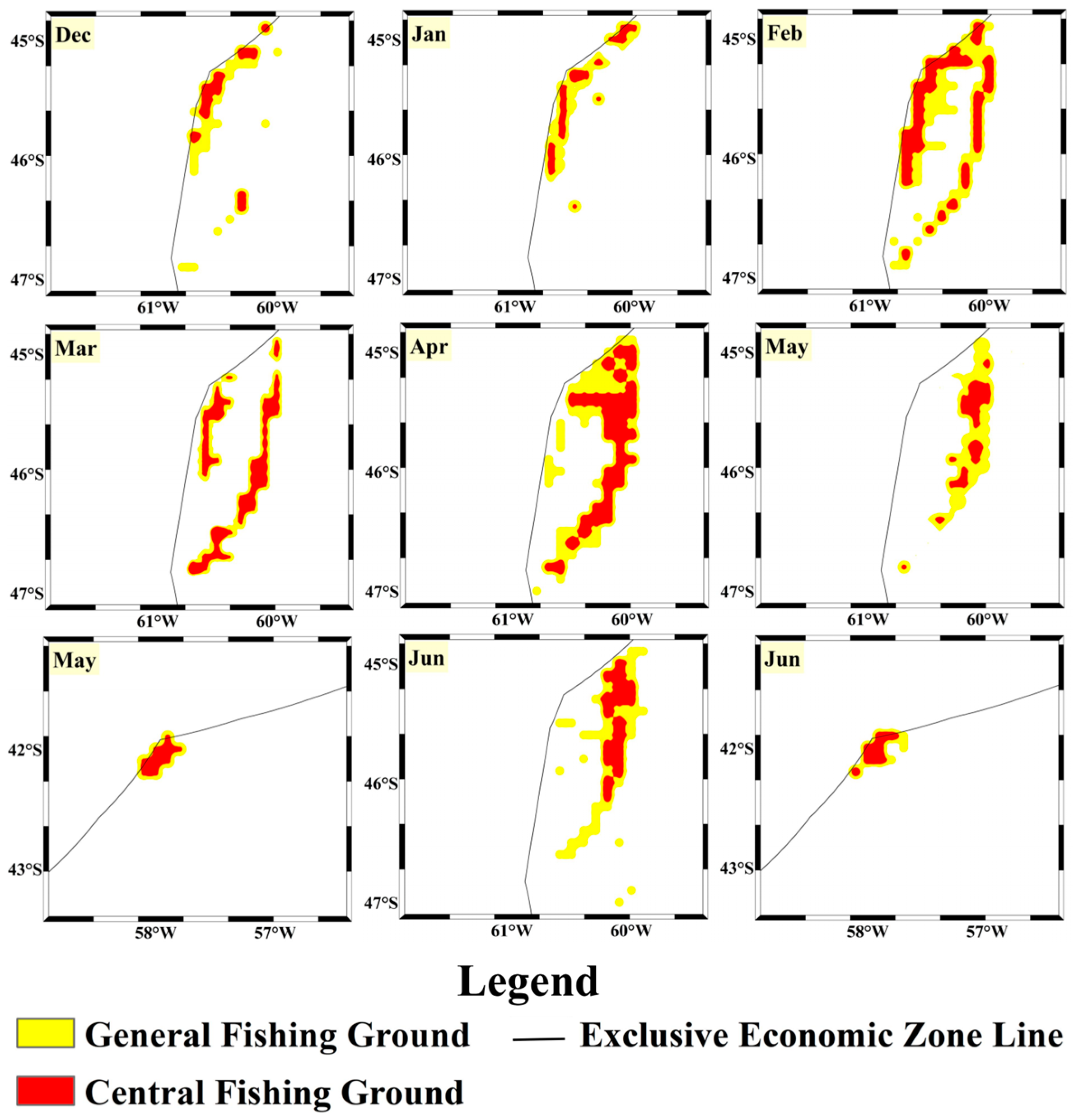



Disclaimer/Publisher’s Note: The statements, opinions and data contained in all publications are solely those of the individual author(s) and contributor(s) and not of MDPI and/or the editor(s). MDPI and/or the editor(s) disclaim responsibility for any injury to people or property resulting from any ideas, methods, instructions or products referred to in the content. |
© 2025 by the authors. Licensee MDPI, Basel, Switzerland. This article is an open access article distributed under the terms and conditions of the Creative Commons Attribution (CC BY) license (https://creativecommons.org/licenses/by/4.0/).
Share and Cite
Xiang, D.; Sun, Y.; Zhu, H.; Wang, J.; Huang, S.; Zhang, S.; Zhang, F.; Zhang, H. Comparative Analysis of Prediction Models for Trawling Grounds of the Argentine Shortfin Squid Illex argentinus in the Southwest Atlantic High Seas Based on Vessel Position and Fishing Log Data. Biology 2025, 14, 35. https://doi.org/10.3390/biology14010035
Xiang D, Sun Y, Zhu H, Wang J, Huang S, Zhang S, Zhang F, Zhang H. Comparative Analysis of Prediction Models for Trawling Grounds of the Argentine Shortfin Squid Illex argentinus in the Southwest Atlantic High Seas Based on Vessel Position and Fishing Log Data. Biology. 2025; 14(1):35. https://doi.org/10.3390/biology14010035
Chicago/Turabian StyleXiang, Delong, Yuyan Sun, Hanji Zhu, Jianhua Wang, Sisi Huang, Shengmao Zhang, Famou Zhang, and Heng Zhang. 2025. "Comparative Analysis of Prediction Models for Trawling Grounds of the Argentine Shortfin Squid Illex argentinus in the Southwest Atlantic High Seas Based on Vessel Position and Fishing Log Data" Biology 14, no. 1: 35. https://doi.org/10.3390/biology14010035
APA StyleXiang, D., Sun, Y., Zhu, H., Wang, J., Huang, S., Zhang, S., Zhang, F., & Zhang, H. (2025). Comparative Analysis of Prediction Models for Trawling Grounds of the Argentine Shortfin Squid Illex argentinus in the Southwest Atlantic High Seas Based on Vessel Position and Fishing Log Data. Biology, 14(1), 35. https://doi.org/10.3390/biology14010035






